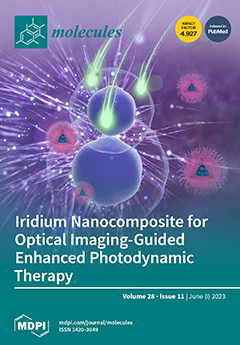The aim of this work is to highlight the influence of blends based on TiO
2 nanoparticles and reduced graphene oxide (RGO) on the photodegradation of acetaminophen (AC). To this end, the catalysts of TiO
2/RGO blends with RGO sheet concentrations equal
[...] Read more.
The aim of this work is to highlight the influence of blends based on TiO
2 nanoparticles and reduced graphene oxide (RGO) on the photodegradation of acetaminophen (AC). To this end, the catalysts of TiO
2/RGO blends with RGO sheet concentrations equal 5, 10, and 20 wt. % were prepared by the solid-state interaction of the two constituents. The preferential adsorption of TiO
2 particles onto the RGO sheets’ surfaces via the water molecules on the TiO
2 particle surface was demonstrated by FTIR spectroscopy. This adsorption process induced an increase in the disordered state of the RGO sheets in the presence of the TiO
2 particles, as highlighted by Raman scattering and scanning electron microscopy (SEM). The novelty of this work lies in the demonstration that TiO
2/RGO mixtures, obtained by the solid-phase interaction of the two constituents, allow an acetaminophen removal of up to 95.18% after 100 min of UV irradiation. This TiO
2/RGO catalyst induced a higher photodegradation efficiency of AC than TiO
2 due to the presence of RGO sheets, which acted as a capture agent for the photogenerated electrons of TiO
2, hindering the electron–hole recombination. The reaction kinetics of AC aqueous solutions containing TiO
2/RGO blends followed a complex first-order kinetic model. Another novelty of this work is the demonstration of the ability of PVC membranes modified with Au nanoparticles to act both as filters for the removal of TiO
2/RGO blends after AC photodegradation and as potential SERS supports, which illustrate the vibrational properties of the reused catalyst. The reuse of the TiO
2/RGO blends after the first cycle of AC photodegradation indicated their suitable stability during the five cycles of pharmaceutical compound photodegradation.
Full article






